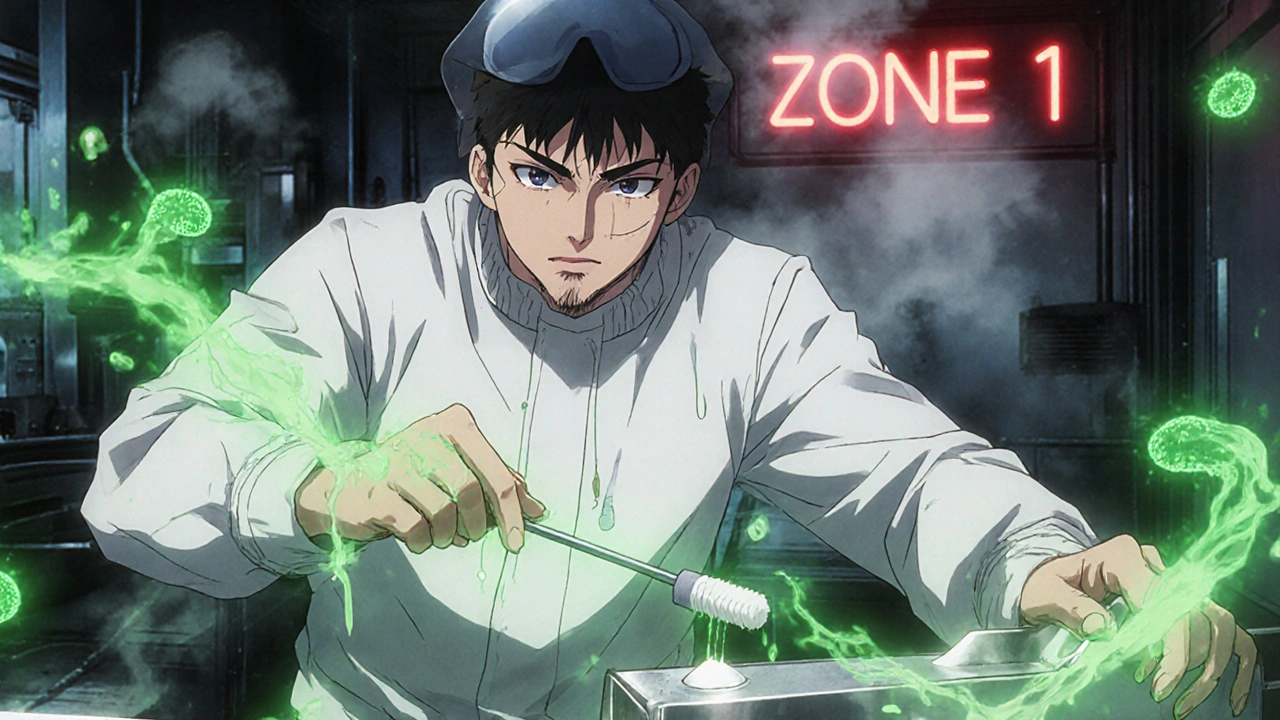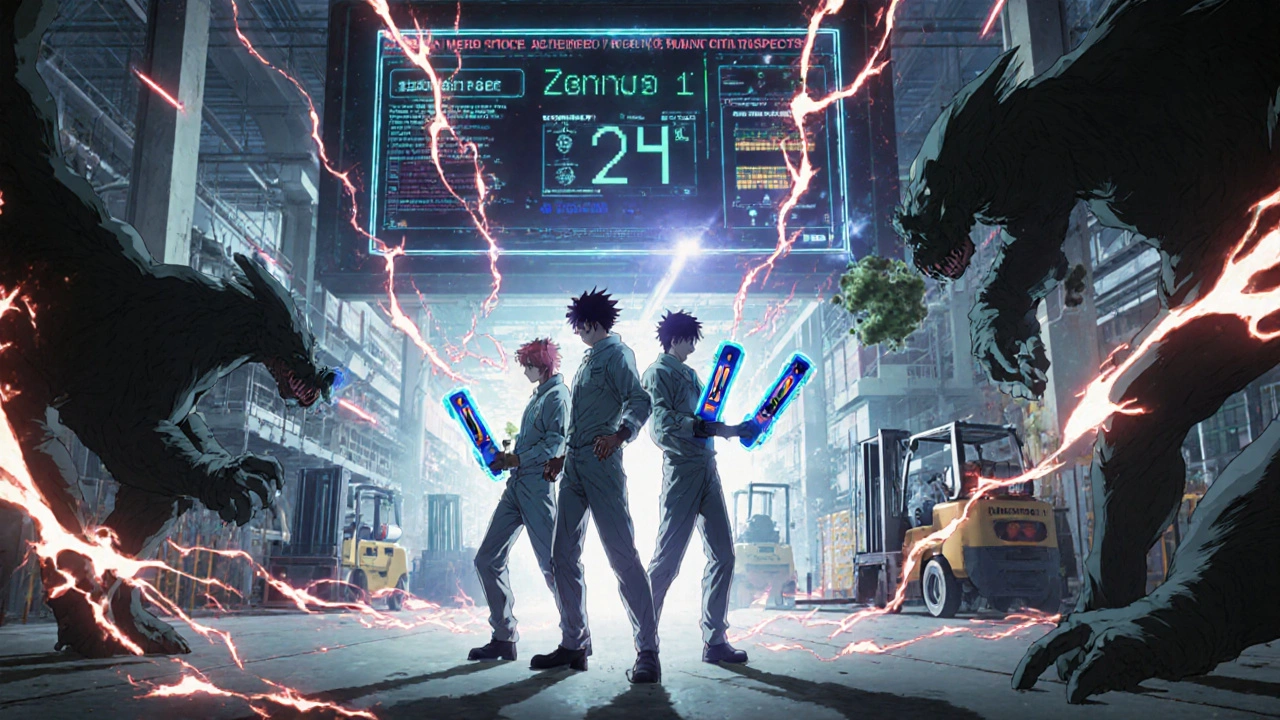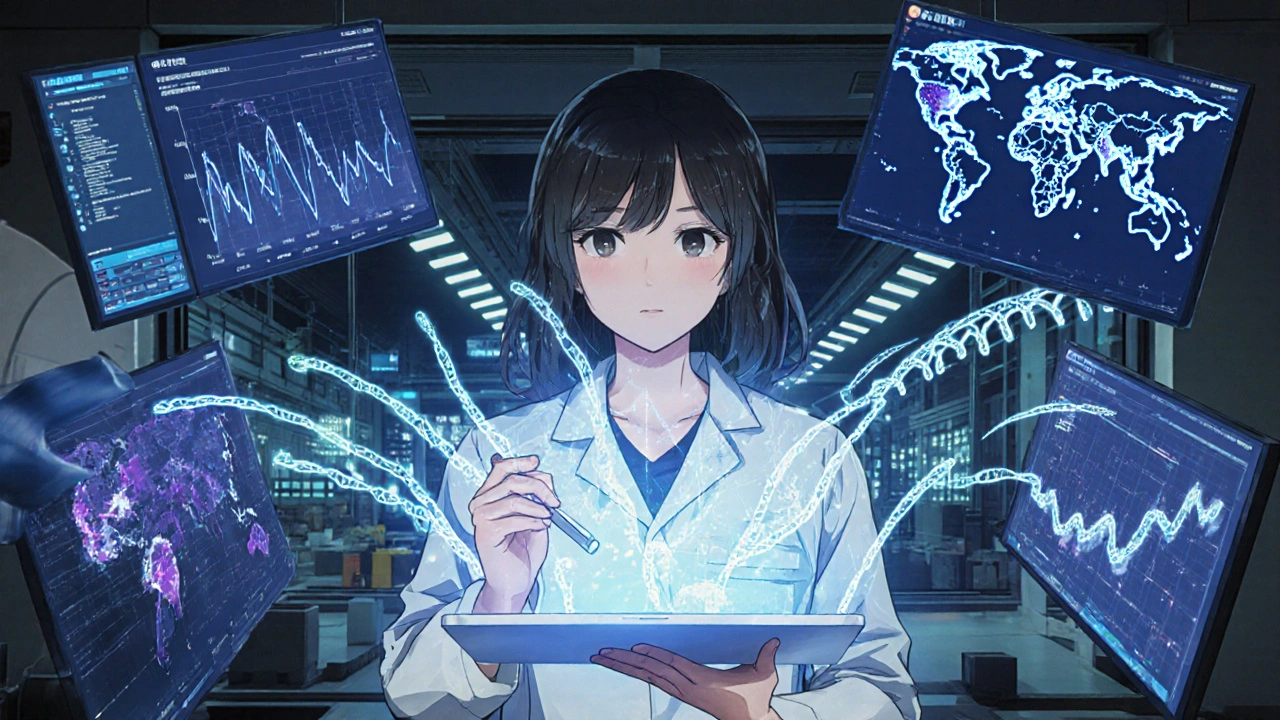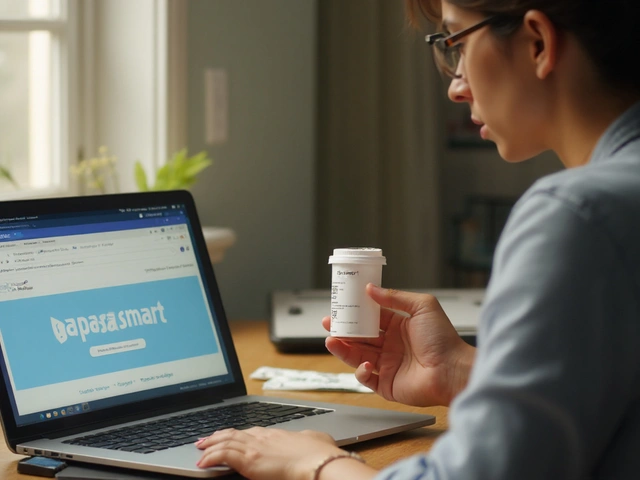
Why Environmental Monitoring Isn’t Just a Box to Check
Imagine running a food processing line, and every morning, you wipe down a slicer with a damp cloth. You think it’s clean. But what if that cloth picks up Listeria monocytogenes-a bacterium that can survive in cold, damp places and cause deadly foodborne illness? Now imagine that same slicer has been used for 12 hours straight, and no one’s tested it in three days. That’s not negligence. That’s a risk most facilities don’t even see until it’s too late.
Environmental monitoring isn’t about being paranoid. It’s about knowing what’s really happening in your facility. The CDC says 87% of foodborne outbreaks tied to environmental contamination could have been prevented. That’s not a small number. That’s the difference between a recall and a lawsuit. Between a brand that survives and one that shuts down.
The Four Zones: Where Contamination Actually Lives
Every facility has zones. Not just physical areas, but risk zones. The industry uses a four-zone system to prioritize where to look-and where to focus your resources.
- Zone 1: Direct food contact surfaces. Think slicers, mixers, conveyors, filling nozzles. This is ground zero. If something’s wrong here, your product is contaminated before it leaves the line.
- Zone 2: Surfaces near food contact. Equipment housings, refrigeration units, nearby walls. These don’t touch food directly, but they’re close enough to drip, splash, or shed particles onto it.
- Zone 3: Remote but still in the production area. Forklifts, carts, floor drains, overhead pipes. You might think these are low risk. But PPD Laboratories found that 62% of all contamination events came from Zone 3 and 4 surfaces. Why? Because people forget to clean them.
- Zone 4: Outside production. Break rooms, restrooms, storage areas. These are the last line of defense. If contamination is here, it’s getting in from outside.
Here’s the hard truth: most facilities spend 80% of their time on Zone 1 and 2. That’s smart. But if you ignore Zone 3, you’re leaving the back door wide open. A drip from an overhead pipe in Zone 3 can end up in your product. And when regulators come in, they check all zones.
What You’re Testing For-and How
Not all contamination is the same. You need the right test for the right threat.
- Microbial testing: Swabs and sponges collect samples from surfaces. Lab cultures identify bacteria like Salmonella, Listeria, or mold. This takes 24-72 hours. It’s slow, but it’s the gold standard.
- ATP testing: This measures adenosine triphosphate, a molecule found in all living cells. A handheld device gives you a reading in seconds. Facilities using ATP see 32% faster turnaround between production runs because they can confirm cleanliness immediately. It doesn’t tell you what’s there-just if something’s there.
- Air sampling: Liquid impingers and solid impactors pull air through a device to capture airborne particles and microbes. Results are in CFU/m³ (colony-forming units per cubic meter). Pharmaceutical cleanrooms require this constantly. Food plants do it too-especially in open-packaging areas.
- Water testing: In pharmaceuticals, water must meet USP <645> standards. Conductivity and TOC (total organic carbon) levels are checked daily. In food plants, it’s about ensuring municipal water meets EPA standards. No one checks water until there’s a problem. Don’t wait.
- Chemical and metal testing: Inductively Coupled Plasma (ICP) detects trace metals. Chromatography finds specific chemicals. These matter in cosmetics and pharma where even ppm levels can cause reactions.
Most facilities use ATP for daily checks and microbial swabs for weekly verification. That’s the sweet spot. Don’t skip the lab tests. ATP tells you if it’s dirty. Microbial testing tells you if it’s dangerous.

Regulations Aren’t Suggestions
Every industry has its rulebook. Ignoring it isn’t an option.
- Pharmaceuticals: EU GMP Annex 1 (updated August 2023) requires real-time monitoring of air quality, temperature, and humidity in cleanrooms. ISO Class 5 (Grade B) is non-negotiable. Continuous particle counters are standard. No exceptions.
- Food processing: The USDA’s Listeria Rule (9 CFR part 430) requires weekly testing of Zone 1 surfaces in Ready-to-Eat (RTE) facilities. If you make deli meats, cheeses, or pre-cut salads, you’re under this rule. The FDA’s Food Safety Modernization Act (FSMA) also requires written environmental monitoring plans.
- Cosmetics: While less regulated than pharma, FDA expects contamination control. If your product causes a skin reaction, they’ll trace it back to your facility’s environmental controls.
Regulators don’t show up to praise you. They come to find gaps. And they know what to look for: swab locations, frequency logs, lab reports, training records. If your documentation is sloppy, your facility fails-even if your numbers look good.
What’s Really Holding Facilities Back
Most facilities have the tools. What they lack is consistency.
- Inconsistent zone classification: One manager sees a pipe above a packaging line as Zone 1 because it drips. Another sees it as Zone 3. That mismatch leads to missed testing. Document your zone definitions. Train everyone on them. Update them annually.
- Poor sampling technique: CDC guidelines say sampler devices must be sterile. Yet 68% of facilities admit to using non-sterile swabs or reusing tools. That doesn’t just give false results-it creates contamination.
- Disconnected data: ATP results, microbial reports, and allergen tests often sit in different spreadsheets. No one connects the dots. If ATP spikes on a Friday and Listeria shows up Monday, you need to know it’s related. Integration tools exist. Use them.
- Understaffing: A medium-sized food plant needs 2-3 full-time people just for environmental monitoring. Small facilities (<50 employees) often assign it to the quality manager who’s already juggling 10 other tasks. That’s a recipe for failure.
Training is the biggest overlooked factor. The FDA recommends 40 hours of hands-on training before anyone touches a swab. That’s not optional. That’s how you avoid false negatives.

Where the Industry Is Headed
Environmental monitoring isn’t staying the same. It’s getting smarter.
- Next-generation sequencing (NGS): Instead of waiting days to grow cultures, labs can now sequence DNA from a swab in under 24 hours. The FDA is pushing this. It’ll catch rare pathogens before they spread.
- AI-powered analytics: Systems now track trends across months. If a particular drain consistently shows mold, AI flags it before it becomes a problem. Market research predicts 38% of facilities will use AI for monitoring by 2027-up from 12% in 2022.
- Real-time sensors: Some pharma plants now have sensors that monitor air quality 24/7 and alert staff if particles spike. That’s the future. Food plants are catching up.
- Antimicrobial resistance: 19% of Listeria strains from food plants now resist multiple antibiotics. Monitoring isn’t just about cleanliness anymore. It’s about tracking evolving threats.
The message is clear: the old way-weekly swabs and paper logs-isn’t enough anymore. You don’t need to go full tech overnight. But if you’re not thinking about automation, data integration, or faster testing, you’re falling behind.
What You Should Do Today
Start here. Don’t wait for an inspection.
- Map your zones. Write down what’s in each one. Get your team to agree.
- Review your sampling frequency. Are you testing Zone 1 daily? Zone 2 weekly? Zone 3 monthly? If not, fix it.
- Combine ATP with microbial testing. Use ATP for daily checks. Use lab tests for weekly verification.
- Train your team. No one should be swabbing without 40 hours of hands-on training.
- Centralize your data. One system. One log. No more Excel files scattered across three computers.
- Check your water. If you’re in food or pharma, you’re required to test it. Are you?
Environmental monitoring isn’t about perfection. It’s about control. You can’t eliminate all risk. But you can know where it is-and stop it before it reaches your product.
Frequently Asked Questions
What’s the difference between ATP testing and microbial swabbing?
ATP testing detects general organic residue-anything living or dead-in seconds. It tells you if a surface is clean, but not what’s on it. Microbial swabbing grows cultures in a lab to identify specific bacteria like Listeria or Salmonella. It takes 1-3 days but tells you exactly what you’re dealing with. Use ATP for daily checks and swabs for weekly verification.
Why are Zone 3 and 4 surfaces so important if they don’t touch food?
Contamination doesn’t always come from direct contact. A drip from an overhead pipe (Zone 3), a dirty forklift tire (Zone 3), or a drain near a production line (Zone 3) can carry microbes into your product. PPD Laboratories found that 62% of all contamination events came from these "lower-risk" zones. Ignoring them is like locking your front door but leaving your basement window open.
How often should I test for Listeria in a food facility?
If you produce Ready-to-Eat (RTE) foods like deli meats, soft cheeses, or pre-packaged salads, USDA regulations require testing Zone 1 surfaces at least once a week. In high-risk areas-like where water pools or condensation forms-you may need to test twice a week. Don’t assume your supplier’s raw materials are clean. The problem is often in your own facility.
Can I use one swab for multiple surfaces?
No. Each swab must be used on a single surface. Reusing a swab transfers microbes from one area to another, creating false negatives or cross-contamination. Always use a new, sterile swab for each sample. This is one of the most common mistakes during inspections.
What’s the minimum staff needed for environmental monitoring?
A medium-sized food or pharma facility typically needs 2-3 full-time staff dedicated to environmental monitoring. This includes sampling, record-keeping, lab coordination, and training. Smaller facilities often assign this to a quality manager, but that increases risk. If you have fewer than 10 employees, consider outsourcing sampling to a certified lab to ensure compliance.
Is environmental monitoring required for small manufacturers?
Yes. Even small facilities under 50 employees are required to follow FDA and USDA rules if they produce regulated products. The USDA found that only 48% of small processors have fully compliant programs. That doesn’t mean they’re exempt-it means they’re at higher risk of being shut down during an inspection. Start small: focus on Zone 1, use ATP, and keep clear records. Compliance isn’t about size-it’s about control.
Write a comment
Your email address will not be published.





13 Comments
I swear, if one more facility thinks ATP testing is a magic bullet, I'm gonna scream. It doesn't tell you if it's Listeria or just dust. I saw a plant shut down last year because they trusted their ATP reader and skipped swabs. Dead baby. Not worth it.
Zone 3 is the silent killer. In our pharma plant, we had a 72-hour Listeria spike traced to a corroded condensate line above the filler. No one cleaned it because it wasn't 'food contact.' Now we have automated CIP for all overheads. Also, I'm still mad about the non-sterile swabs. That's not negligence-it's malpractice.
Man, I used to think this stuff was overkill. Then my cousin got sick from a recalled cheese. Turned out the plant didn't test Zone 3 at all. I just want people to realize: this ain't about rules. It's about not killing folks. Simple as that. And yeah, ATP's great-but don't treat it like a crystal ball. You still need the lab.
The fact that anyone still uses manual swab logs in 2025 is beyond comprehension. If you're not integrating your data into a LIMS with real-time alerts and AI anomaly detection, you're not monitoring-you're gambling. And the FDA knows it. Your 'weekly checks' are just theater. The regulators aren't fooled by pretty spreadsheets.
THEY'RE LYING TO YOU!!! 🚨 The CDC? Big Pharma paid them to downplay Zone 3! I found a whistleblower doc that says 92% of outbreaks come from hidden drains and forklift tires! They don't want you to know because then you'd have to buy their $20k sensors! 🤫💸 #FoodConspiracy
You all think you're so smart with your zones and ATP and swabs. But you know what? The real problem is people. You can have the best system in the world, but if your floor tech doesn't care because he's working double shifts and gets paid minimum wage, you're just playing dress-up with compliance. Fix the people first.
I love how this post breaks it down so clearly. Seriously, if you're reading this and you're in food or pharma-take a breath. This isn't about fear. It's about responsibility. Zone 3 isn't ignored because it's unimportant. It's ignored because it's *inconvenient*. But inconvenience is cheaper than a lawsuit. Or a funeral. You don't need fancy tech to start doing the right thing. Just start. Today.
Oh please. You're all acting like you discovered fire. We've been doing this since the 80s. Your 'Zone 3' is just a fancy term for 'dirty floor.' And ATP? That's just a glorified glow stick. Real professionals use PCR and metagenomics now. If you're still culturing plates, you're 20 years behind. And yes, I've published in J. Food Safety. So I know.
Just a typo in your post: 'PPD Laboratories found that 62% of all contamination events came from Zone 3 and 4 surfaces.' Should be 'PPD Laboratories' or 'PPD Lab'? Also, the FSMA reference is correct but incomplete. Section 110.37 requires written environmental monitoring plans. Just saying.
So let me get this straight. We spend millions on sensors, labs, and compliance officers... just so we don't kill someone with a sandwich? 🤦♀️ I mean, if we're gonna go this hard, why not just make everyone wear hazmat suits and eat only lab-grown tofu? 😅
I work in a small bakery in the UK. We don't have a full-time EM person. But we do a quick ATP check every shift, and we log swabs on a whiteboard every Friday. No fancy software. Just consistency. And guess what? We've never had a recall. Sometimes the simplest things work best.
In India, we don't have your luxury of Zone 1-4. We have 'clean' and 'not clean.' But we still get results. Our team cleans everything twice a day. No ATP. No swabs. Just soap, water, and pride. Your Western obsession with data is just another way to avoid doing the hard work. We don't need your sensors to keep our people safe.
I just found out my sister's baby got sick from a recalled baby food. They tested Zone 1... but not the pipe dripping above the packaging line. That's Zone 3. They didn't even know it was a risk. Now my sister can't sleep. And the company? Still selling the same product. I'm not mad. I'm terrified. And I'm telling everyone I know. This isn't a post. It's a warning.